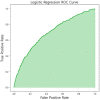Prediction of Emergency Cesarean Section Using Machine Learning Methods: Development and External Validation of a Nationwide Multicenter Dataset in Republic of Korea
- PMID: 35455095
- PMCID: PMC9033083
- DOI: 10.3390/life12040604
Prediction of Emergency Cesarean Section Using Machine Learning Methods: Development and External Validation of a Nationwide Multicenter Dataset in Republic of Korea
Abstract
This study was a multicenter retrospective cohort study of term nulliparous women who underwent labor, and was conducted to develop an automated machine learning model for prediction of emergent cesarean section (CS) before onset of labor. Nine machine learning methods of logistic regression, random forest, Support Vector Machine (SVM), gradient boosting, extreme gradient boosting (XGBoost), light gradient boosting machine (LGBM), k-nearest neighbors (KNN), Voting, and Stacking were applied and compared for prediction of emergent CS during active labor. External validation was performed using a nationwide multicenter dataset for Korean fetal growth. A total of 6549 term nulliparous women was included in the analysis, and the emergent CS rate was 16.1%. The C-statistics values for KNN, Voting, XGBoost, Stacking, gradient boosting, random forest, LGBM, logistic regression, and SVM were 0.6, 0.69, 0.64, 0.59, 0.66, 0.68, 0.68, 0.7, and 0.69, respectively. The logistic regression model showed the best predictive performance with an accuracy of 0.78. The machine learning model identified nine significant variables of maternal age, height, weight at pre-pregnancy, pregnancy-associated hypertension, gestational age, and fetal sonographic findings. The C-statistic value for the logistic regression machine learning model in the external validation set (1391 term nulliparous women) was 0.69, with an overall accuracy of 0.68, a specificity of 0.83, and a sensitivity of 0.41. Machine learning algorithms with clinical and sonographic parameters at near term could be useful tools to predict individual risk of emergent CS during active labor in nulliparous women.
Keywords: cesarean; emergency; labor; machine learning; nulliparous; prediction.
Conflict of interest statement
The authors declare no conflict of interest. The funders had no role in the design of the study; collection, analyses, or interpretation of data; writing of the manuscript; or the decision to publish the results.
Figures








Similar articles
-
Application of machine learning approaches for osteoporosis risk prediction in postmenopausal women.Arch Osteoporos. 2020 Oct 23;15(1):169. doi: 10.1007/s11657-020-00802-8. Arch Osteoporos. 2020. PMID: 33097976
-
Prediction model for the incidence of emergent cesarean section during induction of labor specialized in nulliparous low-risk women.J Obstet Gynaecol Res. 2011 Dec;37(12):1784-91. doi: 10.1111/j.1447-0756.2011.01607.x. Epub 2011 Jul 27. J Obstet Gynaecol Res. 2011. PMID: 21793999
-
Machine learning-based prediction of hospital prolonged length of stay admission at emergency department: a Gradient Boosting algorithm analysis.Front Artif Intell. 2023 Jul 28;6:1179226. doi: 10.3389/frai.2023.1179226. eCollection 2023. Front Artif Intell. 2023. PMID: 37588696 Free PMC article.
-
Applying interpretable machine learning algorithms to predict risk factors for permanent stoma in patients after TME.Front Surg. 2023 Mar 24;10:1125875. doi: 10.3389/fsurg.2023.1125875. eCollection 2023. Front Surg. 2023. PMID: 37035560 Free PMC article.
-
Prediction Model of Osteonecrosis of the Femoral Head After Femoral Neck Fracture: Machine Learning-Based Development and Validation Study.JMIR Med Inform. 2021 Nov 19;9(11):e30079. doi: 10.2196/30079. JMIR Med Inform. 2021. PMID: 34806984 Free PMC article.
Cited by
-
Continued versus discontinued oxytocin stimulation in the active phase of labour (CONDISOX): individual management based on artificial intelligence - a secondary analysis.BMC Pregnancy Childbirth. 2024 Apr 19;24(1):291. doi: 10.1186/s12884-024-06461-8. BMC Pregnancy Childbirth. 2024. PMID: 38641779 Free PMC article.
-
A multimodal model in the prediction of the delivery mode using data from a digital twin-empowered labor monitoring system.Digit Health. 2024 Dec 8;10:20552076241304934. doi: 10.1177/20552076241304934. eCollection 2024 Jan-Dec. Digit Health. 2024. PMID: 39669390 Free PMC article.
-
An AI-based approach to predict delivery outcome based on measurable factors of pregnant mothers.PLOS Digit Health. 2025 Feb 5;4(2):e0000543. doi: 10.1371/journal.pdig.0000543. eCollection 2025 Feb. PLOS Digit Health. 2025. PMID: 39908236 Free PMC article.
-
Enhancing Obstetric Decision-Making With AI: A Systematic Review of AI Models for Predicting Mode of Delivery.Cureus. 2025 May 7;17(5):e83655. doi: 10.7759/cureus.83655. eCollection 2025 May. Cureus. 2025. PMID: 40486431 Free PMC article. Review.
-
Systematic Review of Clinical Prediction Models for the Risk of Emergency Caesarean Births.BJOG. 2025 Feb;132(3):231-240. doi: 10.1111/1471-0528.17948. Epub 2024 Sep 10. BJOG. 2025. PMID: 39256942 Free PMC article.
References
LinkOut - more resources
Full Text Sources
Medical

